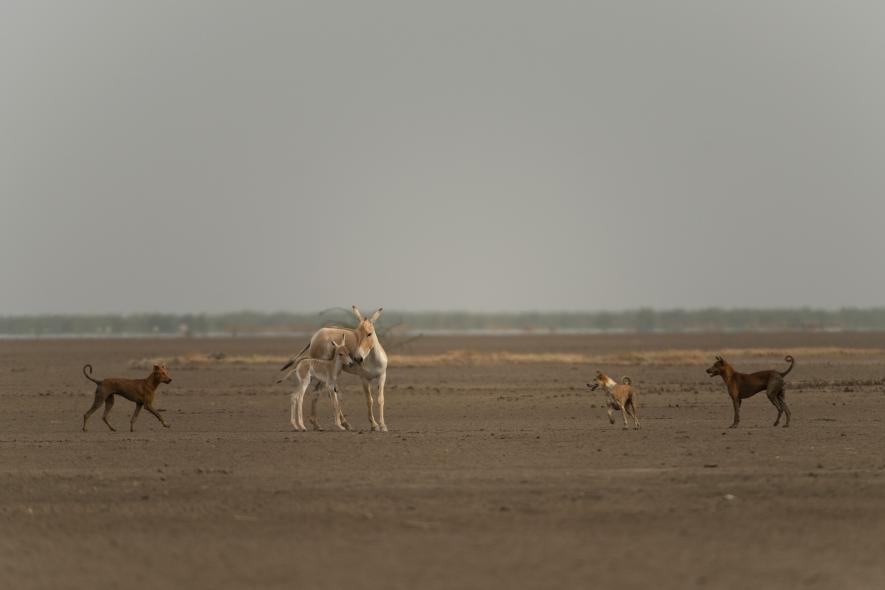Wildlife in Thar Desert Threatened by Free-ranging Dogs, India Lacks Clear Policy Solution
Dog preying on chinkara in Pokhran, Rajashtan. Image Credit: Radheshyam Pemani Bishnoi
On May 19, two chinkaras (Indian gazelles) died after being attacked by stray dogs in Jaisalmer.
“This is a very common problem in every district of chinkara habitat in western Rajasthan,” said Sumit Dookia, a wildlife biologist at Guru Gobind Singh Indraprastha University in New Delhi and scientific adviser to the ERDS Foundation. ERDS is a Rajasthan-based conservation organisation focussing on community participation.
Like the Great Indian Bustard, chinkaras inhabit open, semi-arid habitats which are also preferred by species like the Indian fox and the spiny-tailed lizard. These habitats are often mosaics of agricultural fields and grasslands.
Dookia explained that feral dogs are the biggest reason for declining chinkara populations in western Rajasthan and Jodhpur in particular. Dookia is the lead author of a 2018 paper which evidenced that a majority of injuries and deaths with known causes of chinkara, blackbuck, nilgai and peafowl was due to free-ranging dogs.
More specifically, the paper pegs deaths and injuries due to dogs at 74.28% for chinkara, 68.68% for blackbuck, 55.68% for nilgai and 40.35% for peafowl. Other reasons include road accidents, electrocution and poaching.
“Feral dogs are a major problem, especially in dry and desert areas,” said Kalyan Varma, a wildlife film maker and photographer. “Not only do they decimate wildlife but could carry very high risk of passing on diseases to wild populations,” he added.

Wild ass harassed by dogs in Rann of Kutch, Gujarat. Image Credit: Kalyan Varma
The issue though is pan-India. Conservation India, a volunteer-driven nature conservation website has routinely highlighted how India’s feral dogs are a major threat to wildlife.
“Worldwide there is a huge body of evidence of the impacts of free-ranging dogs on wildlife. The scale of the problem is probably one of the highest in India, which has among the highest number of free-ranging dogs in the world,” said Abi Vanak, convenor at the Centre for Biodiversity and Conservation at the Ashoka Trust for Research in Ecology and the Environment (ATREE).
According to latest estimates, India has a stray dog population of 60 million.
What India needs, Vanak said, is “a zero tolerance policy for the presence of free-ranging dogs in natural areas, especially those that also harbour endangered wildlife”.
What India has, though, is nowhere near adequate.
No clear directive for a solution
In December 2020, the National Tiger Conservation Authority (NTCA) released a Standard Operating Procedure (SOP) to deal with stray and feral dogs in tiger reserves across the country. The document recognises that stray and feral dogs pose threats like direct predation and the spread of diseases and it lays out methods to tackle the same.
“This SOP was drafted after they [NTCA and government of India] were embarrassed that there were more dogs than tigers in many tiger reserves,” said Meghna Uniyal, Director and co-founder, Humane Foundation for People and Animals.
An all-India tiger survey released in 2020 showed that there were more free-ranging domestic dogs than tigers in 17 tiger reserves.
There are, however, major shortfalls in the SOP. “The SOP says that dogs should be sterilised and released in suitable sites. Will sterilisation stop dogs from hunting in packs? Will it stop the spread of diseases? And what are ‘suitable sites’?” Uniyal asked.
Additionally, dogs have a homing instinct and they will try to make their way back to where they were captured from. “Capturing dogs is a big challenge and even if we [forest department] do this, they will find their way back,” said Shruti Sharma, principal chief conservator of forests (PCCF), government of Rajasthan.
Also, “why is the SOP only for tiger reserves?” Uniyal asked. Suffice to say, the SOP is not applicable to Rajasthan’s Desert National Park or even revenue areas where dogs routinely prey on wildlife.
Also read: Great Indian Bustard: Is it ‘Tilting at Windmills’?
“In our area, in summers, a lot of wildlife come to waterholes and this is when they are attacked by dogs,” Shatrunjay Singh, a wildlife enthusiast and resident of Jawai. Jawai is an open area, largely non-forested, located about 150kms from Jodhpur. A very small portion of the land here is under the control of the Forest Department while the remaining are owned by the Irrigation Department, the Revenue Department or local villagers. Same goes for western Rajasthan, too where, Dookia said, “90% of wildlife is outside Forest Department limits.”
“The Thar landscape is a completely different game altogether,” said Kapil Chandrawal, deputy conservator of forests, Jaisalmer and ex-officio director, Desert National Park. Essentially, Chandrawal noted that wildlife is found across the Thar landscape and not just in protected areas and forested areas. “In Desert National Park, we catch dogs and shift them to dog shelters. This operation becomes difficult in areas lying outside (protected areas),” he added.
“This (predation by dogs) happens largely in revenue areas where people stay with domesticated animals - dogs are one of them,” said Mohan Lal Meena, Chief Wildlife Warden, government of Rajasthan. Meena was not willing to engage with further questions.
Declining chinkara populations, increasing dog populations
A 2021 report by the Wildlife Institute of India (WII) pointed to a declining population trend for chinkaras in the Thar landscape. WII is an autonomous body under the Ministry of Environment, Forests and Climate Change (MoEFCC).
The WII report also noted that there is “a rapid increase in numbers and occupancy” of free-ranging dogs. More specifically, the report said that free-ranging dogs, which depend on human-based resources and which hunt wild prey like chinkara, fox, ground-dwelling birds, and lizards, are “a major emerging threat to native wildlife in Thar. Their population and resources need to be urgently managed/controlled.”
Given such population trends, there’s a clear need to devise better strategies to deal with free-ranging dogs.
Pointing to a potential solution, Vanak said given that dogs in rural areas are often under the care of people, a better strategy would be “to work with local stakeholders and improve dog ownership practices, individually identify dogs, encourage owners to vaccinate and restrict free-ranging, and take firm action if any dogs are seen in wildlife areas or are known to kill or harass wildlife.”
(The author is a freelance journalist. The views are personal.)
Get the latest reports & analysis with people's perspective on Protests, movements & deep analytical videos, discussions of the current affairs in your Telegram app. Subscribe to NewsClick's Telegram channel & get Real-Time updates on stories, as they get published on our website.
























